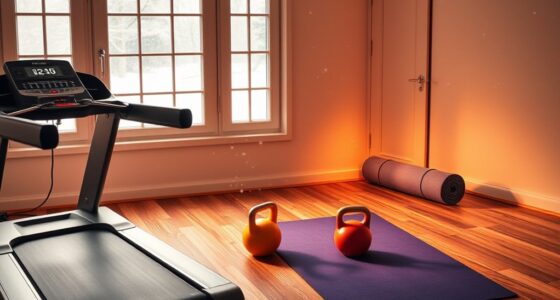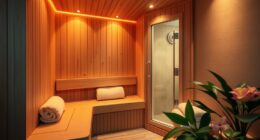Create a fun, safe toddler-friendly obstacle course at home by incorporating low balance beams, tunnels, and stepping stones with cushions or foam. Add sensory elements like textured trays or natural materials to stimulate exploration. Make sure all equipment is non-toxic and secure, with soft mats underneath for safety. Involving your child in choosing or arranging obstacles keeps it engaging. Keep it playful and adaptable, and if you keep exploring, you’ll discover more tips to enhance their development.
Key Takeaways
- Use soft mats, cushions, and non-toxic materials to create safe, cushioned zones for crawling and jumping activities.
- Incorporate balance exercises with a low beam or tape line to develop stability and coordination.
- Add sensory elements like textured trays, water beads, or natural materials to stimulate tactile exploration.
- Design simple challenges such as stepping stones or tunnels to promote motor skill development and confidence.
- Keep the setup colorful, engaging, and adjustable to suit your toddler’s abilities and encourage active play.

Creating a toddler-friendly obstacle course at home is a fun and effective way to keep your little one active and engaged. Not only does it promote physical development, but it also fosters their confidence and curiosity. When designing the course, focus on activities that incorporate balance exercises and sensory play, which are vital for your child’s overall growth. Balance exercises help your toddler develop coordination and stability, essential skills as they learn to walk, run, and climb. You might set up a low balance beam using painter’s tape or a narrow strip of wood on the floor. Encourage your child to walk across it slowly, helping them practice stability and control. To make it more exciting, you can add variations like balancing on one foot or gently tossing small soft objects onto the beam to challenge their focus and balance further.
Sensory play is another key element that stimulates your child’s senses and keeps the course engaging. Incorporate tactile elements such as a tray filled with rice, beans, or water beads, where your toddler can scoop, pour, and explore different textures. You might also include a small tunnel made from soft fabric or cardboard boxes to crawl through, which adds a tactile and proprioceptive dimension. These activities encourage exploration while promoting motor skills and sensory integration. Additionally, incorporating natural materials like leaves or pinecones can enhance their connection to the environment and enrich sensory experiences. When creating the course, keep safety in mind by ensuring all items are stable and non-toxic, and that the space is free of hazards. Soft mats or rugs underneath the activities provide a cushioned surface, giving your child a safe landing if they stumble or fall.
You can also add simple challenges like stepping stones made from cushions or foam mats, which help develop foot placement awareness and reinforce balance exercises. Incorporate visual cues with bright colors or pictures to stimulate your child’s visual senses and make the course more inviting. As you set up each station, involve your toddler in the process, allowing them to choose or help arrange the obstacles. This encourages their independence and excitement for the activity. Remember, the goal is to keep it playful and adaptable; if something seems too difficult or unsafe, adjust or remove it. By combining balance exercises with sensory play, you create a dynamic environment that promotes physical, sensory, and cognitive development—making your home a fun playground where your toddler can learn, explore, and grow confidently.
Frequently Asked Questions
What Safety Precautions Should I Take During Setup?
You should start with hazard identification, checking for sharp edges, loose parts, or unstable items that could cause injury. Make certain all equipment is sturdy and secure before your child begins. Maintain constant supervision, actively watching your toddler as they navigate the course. Clear the area of any small or choking hazards, and encourage safe play. Using supervision strategies like setting boundaries and explaining safety rules helps prevent accidents and keeps your child safe during setup.
How Do I Modify the Course for Different Ages?
You can modify the obstacle course for different ages by adjusting the challenges to be age-appropriate. For younger kids, use soft, low obstacles and simpler tasks. For older children, add more complex challenges like climbing or balancing activities. Incorporate adaptive modifications, such as wider pathways or supportive mats, to guarantee safety and engagement for all ages. Always observe their abilities and modify accordingly to keep it fun and safe.
Are There Recommended Materials for Durability?
You should choose durable materials like thick foam, sturdy plastic, and strong fabric for your obstacle course. Recommended supplies include high-quality foam mats, heavy-duty cones, and reinforced ropes or tunnels that withstand active play. Avoid flimsy or easily worn-out items. Using these durable materials guarantees safety and longevity, keeping your toddler entertained and secure as they explore and develop their motor skills.
How Much Space Is Needed for a Safe Course?
You’ll need at least a 6×6-foot space for a safe indoor playground or outdoor obstacles course. This area provides enough room for toddlers to move freely without feeling cramped. Make sure the space is clear of sharp or hard objects, and consider soft mats or grass for added safety. A well-sized area helps prevent accidents and keeps your little one engaged and active while exploring the various outdoor obstacles.
How Can I Motivate My Toddler to Participate?
You can motivate your toddler to participate by offering fun incentives and providing plenty of parental encouragement. Celebrate their efforts and progress to boost confidence, making the experience enjoyable. Use playful language and cheer them on enthusiastically. Incorporate small rewards like stickers or extra playtime, which can make the activity feel like a fun adventure. Your positive reinforcement and enthusiasm will inspire your toddler to join in ardently and keep trying.
Conclusion
Creating a toddler-friendly obstacle course is like building a mini adventure land right in your home. It encourages your little one to stay active, develop new skills, and most importantly, have fun. Plus, it’s easy to change up as they grow or interests shift. With a little imagination and some simple supplies, you turn your space into a playground that sparks joy and curiosity. So, get started and watch your child’s confidence soar like a kite in the sky!










